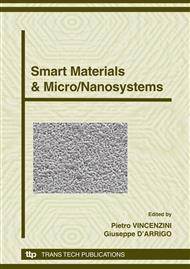p.158
p.168
p.174
p.180
p.187
p.195
p.201
p.211
p.216
Development of Multi-Ferroic Actuator/Sensor Material and Device for Intelligent/Smart Technology - Basic Design and Experimental Verification
Abstract:
Technical importance of multi-ferroic approach for designing advanced multi-functional actuator/sensors based on a mutual coupling effect between ferroic material elements is pointed out for intelligent/smart technology. Two types of multi-ferroic actuator/sensor devices. i.e. (1) magnetically driven composite actuator and (2) multi-functional surface acoustic wave (SAW) sensor by MEMS are presented. First, a large-scale robust composite actuator is the composite structure which is reinforced by the superelastic fiber or lamellar of shape memory alloys (TiNi) in the ferromagnetic metal (Ni) matrix. This multi-ferroic composite can be driven with high speed as well as considerably enhanced strain by applying a wireless magnetic field. Secondarily, multi-functionally designed, multi-ferroic senor device using surface acoustic wave (SAW) is introduced. On the surface part between IDTs, environmentally active material films such as SMA, FSMA, magnetostrictive alloy etc. are formed by magnetron-sputtering. Various environmental sensing parameters i.e. temperature, magnetic field strength, stress, loading hysteresis and internal damage etc. can be evaluated nondestructively from the signal analysis of amplitude and phase change of SAW. Consequently, these results show the promising new types of multi-functional composite actuator and sensor based on multi-ferroic effect.
Info:
Periodical:
Pages:
187-194
Citation:
Online since:
September 2008
Authors:
Price:
Сopyright:
© 2008 Trans Tech Publications Ltd. All Rights Reserved
Share:
Citation:


